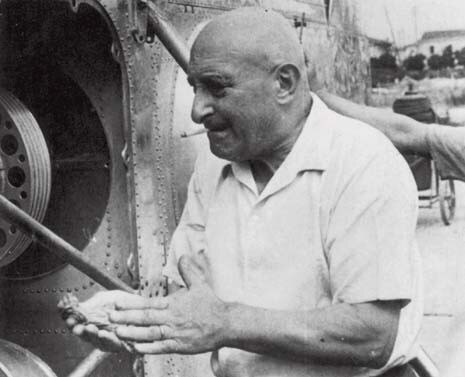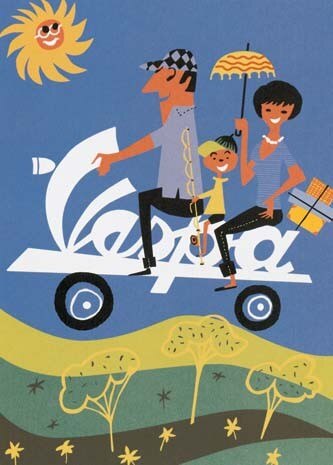Vespa. Un’avventura italiana nel mondo, AAVV, Giunti Editore, Firenze, 2003 (pp. 335, Euro 25,00)
It is singular that only a limited number of books have addressed the lovable Piaggio scooter since it appeared in 1946. Not only has it been very popular, it is always present in Italians’ memories, and it has played a central role in the private and collective experience of one’s first vehicle.
The dearth of books on the Vespa testifies to another of Italy’s idiosyncrasies (though this one isn’t trifling). Italy remains resistant to recognizing that expressions of everyday culture are worthy of critical, theoretical and historical attention, even when they are identified with huge pieces of the nation’s material, manufacturing and economic history.
This is a symptom of schizophrenia, or at least absentmindedness, particularly in light of the reams of paper devoted to catalogues, brochures and magazines documenting the great dream of Italian luxury that has apparently swept Italy. Of course, the Vespa ‘cannot’ belong in this category; it was a product churned out by the millions in a real factory, created by an engineer rather than a fashion designer or artist.
Like other Italian habits, this generates a delay in the ‘discourse’ on issues that elsewhere have been fully tackled and integrated into common wisdom (in the meantime, the Ruhr has become a new European metropolis, its steel mills converted to culture centres).
Furthermore, there are lapses of memory that are all the more serious considering that Vespa’s qualities and history correspond to very current and pressing notions, such as the increasing necessity of redefining industrial strategies and ‘skills’. This scooter achieved perfection in relating sculptural form to function. There have been many major efforts, though not all of them succeeded, to revamp the product and maintain its identity, not unlike the fad of ‘retro design’ that produced the new Mini and Bug.
Vespa’s industrial design solutions were original, ranging from low-cost technological innovation to aeronautic and military engineering applied to conventional industry. Also significant were the role played by the designer – Corradino d’Ascanio, an aeronautical engineer and patent holder, not a designer proper – and the duration of the formula (more than 50 years), which coincided with the great period of Italian industrial design, the emerging mantra of corporate literature.
From the standpoint of daily culture, in addition to representing the best industrial design, the Vespa was a contemporary myth and an indelible icon of Italy’s international image.
Symbolizing the sweet road to modernity, it was accessible since it was lovable. These ‘immaterial’ cultural values made the Vespa very popular in movies, including Roman Holiday with Gregory Peck and Audrey Hepburn (Oscar, 1953) and Nanni Moretti’s Caro Diario (Golden Palm, Cannes, 1993). Loaded with many levels of significance, it became a totem around which mass tourism and the invention of leisure activities gradually formed, as in the Vespa Clubs. It was also involved in epoch-making social phenomena (feminism), youth groups engaged in developing consumer aesthetics (Britain’s mods) and late-romantic individualist adventures (solitary Vespa riders crossing the Gobi Desert).
This engaging publication was edited by the architect Davide Mazzanti and Ornella Sessa, a lecturer in the University of Florence’s industrial design programme. Published by Giunti and the product of close collaboration between the Historical Museum and the Piaggio archives, the work briskly and thought-provokingly addresses all of the above-mentioned topics.
The volume historically reconstructs the design evolution of the individual two-wheeled vehicle, a narrative that alternates with the story of the firm that still makes it (the latest Vespa Granturismo has just been delivered to dealers). Perhaps it would have been better to omit the long chronological study of each model, but the book is obviously aimed at the Vespa aficionados, who will value the minor details that are typical of publications on classic cars. Luckily, the field of design is used to probe both the details and the formal and functional solutions of the various models. The publication examines the interaction between a variety of communications and the development of the popular consumer cult, to which Piaggio has always cleverly catered with its attention to the object’s seductive power, social context and vocabulary.
Lastly, the book offers an overview of the historic, technological and economic links that represent the Vespa’s ‘cultural capital’. The true nature of Piaggio before the invention of the Vespa remains to be seen – a task for interdisciplinary research, not just design. What kind of business intelligence did Enrico Piaggio’s top management have to be able to define the design brief for a private-sector product during the final year of World War II? That is, how did the early-20th-century Italian culture of heavy industry engender the most elegant, light and intelligent scooter ever made?
Giannino Malossi, design critic and researcher




